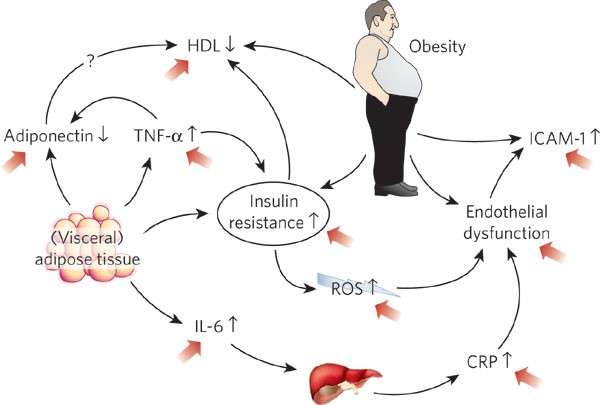Obesity is often associated with a host of health problems, but its connection to atherosclerosis—a condition commonly known as the hardening of the arteries—remains a serious yet often overlooked risk.
While we tend to focus on obesity’s more visible impacts, such as joint pain or diabetes, the insidious link between obesity and atherosclerosis is what truly deserves attention.
So, how exactly does carrying extra weight contribute to clogged arteries and cardiovascular disease?
Let’s explore this hidden danger and understand the science behind it.
“How Obesity Fuels Atherosclerosis” Article Index:
- What is Atherosclerosis?
- How Does Obesity Contribute to Atherosclerosis?
- The Role of Inflammation in Atherogenic Obesity
- Is Atheromatous Aorta Dangerous?
- Why is Atherosclerosis Dangerous?
- Side Effects of Hardening of the Arteries
- Is Mild or Moderate Atherosclerosis Dangerous?
- FAQs on Atherosclerosis and Obesity
- Strategies to Reduce Atherosclerosis Risk in Obesity
- Conclusion: Can We Manage the Hidden Cardiovascular Risk?
What is Atherosclerosis?
How Does Obesity Contribute to Atherosclerosis?
Atherosclerosis and obesity are linked through multiple pathways.
Excess fat, especially visceral fat, can trigger a chain reaction that promotes inflammation and metabolic disturbances. This chronic inflammation damages the arterial walls, making them more susceptible to plaque accumulation.
This phenomenon is often referred to as atherogenic obesity, highlighting how the condition encourages the formation of atherosclerosis.
A study published in the Journal of the American College of Cardiology demonstrated that obese individuals are more likely to have high levels of LDL cholesterol and triglycerides—both of which contribute to plaque build-up in the arteries.
This makes obesity not just a risk factor for atherosclerosis, but also a driver of its progression.
The Role of Inflammation in Atherogenic Obesity
Obesity is characterized by chronic low-grade inflammation, which plays a pivotal role in the development of atherosclerosis.
This obesity inflammation and atherosclerosis connection is primarily due to adipose tissue (fat tissue) releasing pro-inflammatory cytokines like TNF-alpha and IL-6.
These cytokines promote the recruitment of immune cells to the arterial walls, leading to further inflammation and the progression of atherosclerotic plaques.
A study published in Arteriosclerosis, Thrombosis, and Vascular Biology found that obese individuals exhibited higher levels of these inflammatory markers, correlating with an increased thickness of arterial walls—a precursor to atherosclerosis.
Is Atheromatous Aorta Dangerous?
An atheromatous aorta refers to the build-up of fatty deposits within the aorta, the body’s largest artery.
So, is atheromatous aorta dangerous?
Absolutely.
It can lead to complications like aortic aneurysm or even rupture, both of which can be fatal.
The presence of atheroma in the aorta is often a sign of widespread atherosclerosis, indicating that other arteries may also be affected.
Why is Atherosclerosis Dangerous?
Understanding why atherosclerosis is dangerous is crucial for grasping the severity of this condition.
As plaque builds up, the arteries become less flexible, making it harder for blood to flow.
This restricted blood flow can result in chest pain, heart attacks, or even strokes. This is a classic case of cardiac overload.
In some cases, a plaque can rupture, leading to a blood clot that can completely block the artery.
This is why atherosclerosis is often a silent killer, progressing unnoticed until a severe event occurs.
Side Effects of Hardening of the Arteries
The side effects of hardening of the arteries go beyond the obvious cardiovascular risks.
Restricted blood flow can also lead to peripheral artery disease (PAD), where the legs or arms do not receive enough blood flow, causing pain and muscle cramps.
Additionally, reduced blood flow to the brain can result in cognitive decline and increase the risk of dementia.
Is Mild or Moderate Atherosclerosis Dangerous?
You might wonder, is mild atherosclerosis dangerous?
Or even is moderate atherosclerosis dangerous?
While these conditions may not cause immediate symptoms, they are far from harmless.
Mild atherosclerosis can progress silently over time, becoming severe and symptomatic.
Moderate atherosclerosis indicates that a significant portion of the artery is already compromised, increasing the risk of a cardiovascular event.
A study published in the American Heart Journal found that individuals with moderate atherosclerosis had a higher risk of heart attacks compared to those with no arterial plaques, even in the absence of traditional symptoms.
FAQs on Atherosclerosis and Obesity

Strategies to Reduce Atherosclerosis Risk in Obesity
- Healthy Diet: Adopting a heart-healthy diet rich in fruits, vegetables, and whole grains can help reduce LDL cholesterol levels and minimize plaque formation. I have successfully lost several pounds of unwanted body fat drinking fruit smoothie recipes for weight loss that are high in nutrition and low in calories.
- Regular Exercise: Physical activity such as bodyweight exercises can lower blood pressure, reduce cholesterol levels, and promote weight loss, all of which can decrease atherosclerosis risk.
- Medications: Statins and other cholesterol-lowering medications can be effective in reducing the risk of atherosclerosis in obese individuals.
- Lifestyle Modifications: Reducing smoking and alcohol intake can further decrease the risk of developing atherosclerosis.
Takeaway: Can We Manage the Hidden Cardiovascular Risk?
So, does obesity truly fuel atherosclerosis, creating a hidden cardiovascular risk?
The answer is a resounding yes.
The relationship between atherosclerosis and obesity is complex and multifaceted, involving factors like inflammation, lipid metabolism, and chronic disease states. This makes obesity not just a risk factor but a potent catalyst in the development of atherosclerosis.
Addressing obesity through lifestyle changes, medical interventions, and public health policies can significantly reduce the incidence of atherosclerosis and improve overall cardiovascular health.
While the battle against obesity and its side effects is challenging, understanding the connection between these conditions is a crucial first step in mitigating the hidden dangers that lie within.
References:
